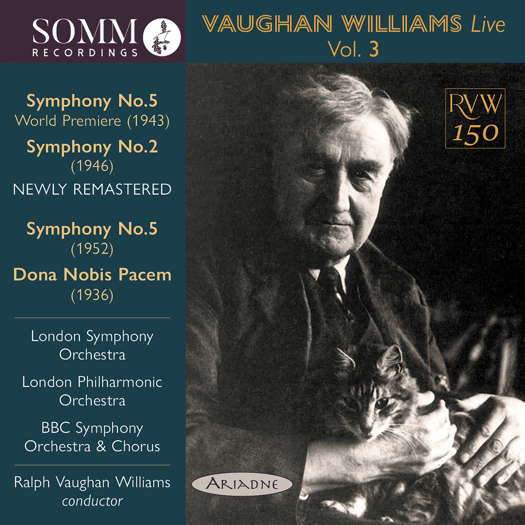
An Important Historical Document
PATRICK MAXWELL listens to Vaughan Williams conducting Vaughan Williams
'... a typically ebullient and undogmatic interpretation of two central works of Britain's most popular composer.'
The life of Ralph Vaughan Williams (1872-1958) was exceptionally long and saw some of the most far-reaching, dramatic and fundamental changes in the makeup of the society into which he had been born. This has made him very susceptible to the kind of half-baked musicology which scans the composition date of a piece of music and makes parallels between the ascertained mood of the piece and the general political state of the time in which it was written. It is the kind of thing too often done to Shostakovich, whose life was tainted in many ways but not marred by the Soviet regime's control; neither was everything written in the two World Wars, for instance, similarly imbued with reactions to the horrible contemporary conflicts.
I say this because Vaughan Williams' Fifth Symphony is one of his most pastoral, bucolic and serene. It was composed in 1943 - one of the most destructive years in human history. Vaughan Williams' pastoral vision of England had been attacked by consistent bombing raids, and the scale of destruction in Europe was greater and more widespread than that he had viewed first-hand on the fields of Flanders in the First War. Whereas his Pastoral Symphony has been mistakenly viewed as an idyllic description of England - when in fact it was inspired by the grim sights of war-ridden France - the Fifth bars any attempt at fixing upon it the labels of political reaction or personal horror. The music is simply of a completely different character to any such attempts. Such a reflection would come, in fact, with Vaughan Williams' Sixth, a wonderfully powerful and emotive reaction after the end of the war.
This new release from SOMM places particular importance on the historical context of the Fifth, with two recordings of the piece conducted by the composer himself. With the London Philharmonic Orchestra giving the premiere in 1943, what survives here is a spirited and passionate recording of one of the composer's most personal expressions. Given the limited technology of a wartime listener, there are gaps throughout these recordings in the middle of certain movements, but their interest as historical documents is not in doubt. The third movement of the Fifth Symphony is often described as the 'heart' of the piece: it contains material which the composer re-used in his lifelong project to complete an opera on Bunyan's Pilgrim's Progress, completed in 1951. In the 1943 recording, the timeless quality of the opening chords and wandering cor anglais solo is mesmerising, with the composer taking the music's movement truly into his own hands.
Listen — Vaughan Williams: Romanza (Lento) (Symphony No 5)
(ARIADNE 5019-2 CD1 track 14, 0:02-0:54) ℗ 2022 SOMM Recordings :
There is not quite the precision of later recordings like Andrew Manze's wonderful discs with the Royal Liverpool Philharmonic, but the belief of the orchestra at the work's premiere, and the conductor's hold on his own music, makes for powerful listening.
The Fifth was dedicated, without permission, to Sibelius. The Finnish composer was delighted to receive it; it's easy to hear why. The first movement, with its meandering, lilting string lines and distinctly reflective quality, evokes Sibelius' sonorous and tranquil universe more clearly than any other English composer of the time. Vaughan Williams' score has more breadth, more life, but the first movement can be beguiling, even frustrating, with the sheer pleasure it takes in taking up musical time. In the second recording here, from 1952, the first movement has slightly more pace and freshness; the bright chords which announce new sections come with more anticipation from the orchestra.
Listen — Vaughan Williams: Preludio (Moderato) (Symphony No 5)
(ARIADNE 5019-2 CD2 track 1, 0:01-0:52) ℗ 2022 SOMM Recordings :
Despite the criticism of Vaughan Williams' conducting style during his life - he was fond of merely giving clear beats and leaving the rest to musicianship - these recordings display an orchestra clearly in unison with the composer's intentions. Each drop of typical Vaughan Williamsian colour is treated with an urgency and expressivity which could only come from having the figure himself standing on the podium.
The Second Symphony, first performed almost thirty years before the Fifth, shares many of those same colours and contours which make up the heart of Vaughan Williams' style. The composer's gift of a vague programme for this work - hence its title 'The London' - is unusual: he usually abhorred such extra-musical suggestions. Bloomsbury Square, the Thames Embankment, Big Ben - all are evoked in this work of 1914. It is a full portrait of Edwardian London before the First World War, with something of a nostalgic sense that Vaughan Williams presented equally potently in his rural landscapes. This recording from 1946 shows the composer at the height of his prestige and powers in England: the Sixth Symphony was released to acclaim the same year, and his harking-back to previous times of ease and simplicity struck many chords in the battered British musical psyche of the war. Only during the 'Fifties did the modal and profoundly expressionistic language of Vaughan Williams' style begin to fall out of fashion. All such qualities are on show in this powerful if difficult recording. Difficult not only because of the sound quality, but also for the playing of the London Symphony Orchestra, which is not as piercing as that of the Philharmonic's three years before.
Listen — Vaughan Williams: Lento - Allegro risoluto (Symphony No 2)
(ARIADNE 5019-2 CD1 track 3, 0:07-1:06) ℗ 2022 SOMM Recordings :
Dona Nobis Pacem is one of Vaughan Williams' more persuasive choral pieces, and one where he shows the developed contrast of solo voice and chorus which had handicapped his earlier writing. Renée Flynn provides a beautiful soloist for the work, with the close-microphone style typical of the mid-century particularly powerful at the work's opening, and in the moments of tender reflection from Roy Henderson. The sound from the BBC Symphony Chorus is of an especially Romantic quality, which gives the piece some strangely Elgarian overtones. Its aethereal, meltingly sweet quality was seen as sentimental by the middle of the century, but this recording from 1936 makes for acutely impactful listening of a work that presents a different side to the composer. Only two years separate it from the contrasting quietude of the Serenade to Music; here the call to 'give us peace' has definite contemporary overtones in the middle of that most unpeaceful decade. Simon Heffer - who has written an excellent short biography of the composer - provides some eloquent and useful context for this time of change and anxiety in Vaughan Williams' life.
Listen — Vaughan Williams: O man greatly beloved (Dona Nobis Pacem)
(ARIADNE 5019-2 CD2 track 10, 6:18-7:15) ℗ 2022 SOMM Recordings :
This disc is, though, not only an important historical document. It provides a typically ebullient and undogmatic interpretation of two central works of Britain's most popular composer. The fact they are vaughan Williams' own does not necessarily make them all the more worthy: Adrian Boult was often known to discuss his differing tempi and choices for the Second Symphony with the man who wrote it and present them just as convincingly. What survives most evidently is that sheer joy with which the three orchestras here have in the work of Vaughan Williams' sweeping, elegiac, vigorous musical world.
Copyright © 28 December 2022
Patrick Maxwell,
Buckinghamshire, UK

CD INFORMATION: VAUGHAN WILLIAMS LIVE - VOL 3




